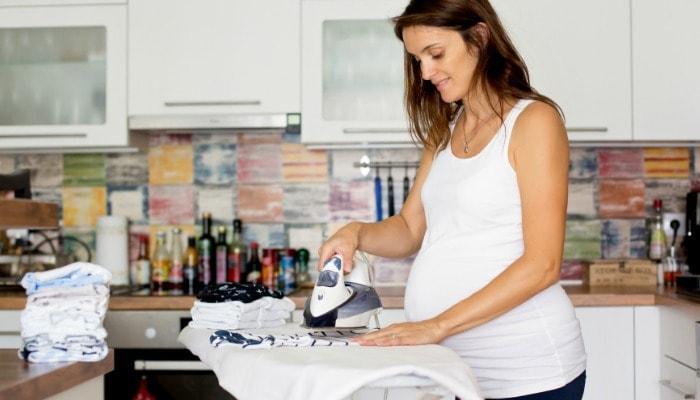Early Labor: How to spot It and What to Do
Early Labor: How to spot It and What to Do
Early labor is the beginning of the first stage of labor, the longest part of the birthing process. Early labor is a combination of end of pregnancy symptoms mixed with signs of labor, which sometimes makes things unclear if what’s happening is pre-labor or the real deal.
Use this guide to help identify signs of early labor, but also for ideas on how to cope and what to do. Let’s get started!
Early Labor: How to Identify It and What to Do
When learning about the first part of labor, it’s helpful to understand where early labor falls in the entire process. Below are descriptions of the three stages of labor, with early labor being at the beginning of the first stage.
Stage 1
Early Labor
Active Labor
Transition
Stage 2
Pushing and the Birth of the Baby
Stage 3
Delivery of the Placenta
What is Early Labor?
Early labor is the beginning of the first stage of labor, when contractions are short, around 30 seconds long, and somewhat irregular, around 5-7 (or even longer) minutes apart. At this point the cervix is dilated less than 6 cm. (SOURCE)
In early labor parents can walk and talk through their contractions. Oftentimes, onlookers have no idea what’s actually happening because these milder contractions can be masked by a woman determined to continue on with her daily life.
In early labor parents may notice that contractions
don’t go away or space out after a glass of water or two, rest or shower.
start feeling different than braxton hicks contractions. For example, in early labor contractions may migrate to the back, whereas previously they were only in the front.
get stronger, longer and closer together.
Signs of Early Labor
In early labor it is common for women to experience other signs of labor, besides just contractions.
Parents may notice
Simply because you have one or even two of the signs of labor above, doesn’t necessarily mean that you’re in labor. For example, say a woman has a vaginal exam at 39 weeks and finds out she’s 5 cm dilated. After the exam she notices a flurry of braxton hicks contractions.
Does it mean she’s in labor? Not necessarily. However, if she her contractions get progressively longer, stronger, and closer together, she could be in labor.
On the flip side, a woman could be in early labor and not experience many of the signs of labor listed above. For example, a woman could be in early labor but not have loose stools, lose her mucus plug, or have her water break.
FYI: A woman can be in early labor without her water breaking.
What Do Contractions Feel like in Early Labor?
Many parents want to know what early labor contractions feel like. By understanding how other women experience the beginning of labor it helps them figure out what’s going on with them too.
However, I will say that every woman is different and every birth is different. Check out this post about what contractions feel like in labor. You’ll notice that there is a wide range of answers!
In early labor the average women experiences some pain and pressure in their back, the lower abdomen, and/or both. Some women compare early labor contractions like mild to moderate period cramps.
What did your contractions feel like at the beginning of labor? Leave a comment and share it with the Mother Rising community!
Is it Prodromal Labor or Early Labor?
Sometimes parents experience early labor contractions that don’t become longer, stronger, or closer together. This is not labor, but something called prodromal labor.
Prodromal labor is a variation of early labor. The difference between prodromal labor and early labor is that the contractions of early labor get longer, stronger and closer together but also dilate the cervix up to six centimeters.
Some women may never experience prodromal labor, but most will have some form of early labor.
How to Cope through Early Labor
Here are some practical and fun ways to cope through the beginning parts of labor.
The following is a list of activities that are not helpful during early labor.
Posting labor updates on social media. (The well-meaning texts, messages, and calls that will ensue can become stressful, especially if things take longer than anticipated.)
Going to the hospital too early. (Unless medically indicated, the best place to be in early labor is at home.)
Getting out of bed or waking your parter at 2 am. (Rest should be priority!)
The Best Advice Ever
If you do one activity on the list above, let it be “take a nap”, and be sure to rest between contractions.
Especially for first time moms, the pain of labor isn’t the only thing that’s challenging, it’s also exhaustion. Sure, labor pain encourages mothers to get an epidural, but it’s also exhaustion.
If you wake up in the middle of the night and notice early labor contractions PLEASE try and go back to sleep. If you can’t sleep, simply be still in your bed in the dark. Do not turn on any lights, but rest your body and mind. And make sure to not wake your partner! Let them sleep too. You both need your rest as you have a lot of work in front of you!
A Recap
To recap, the following are the phases of labor that a women will go through to give birth to her baby.
What comes next in the first stage of labor? Active labor! Head on over here to read all about active labor, when to go to the hospital, and how to cope.
Stage 1
Early Labor
Active Labor
Transition
Stage 2
Pushing and the Birth of the Baby
Stage 3
Delivery of the Placenta
